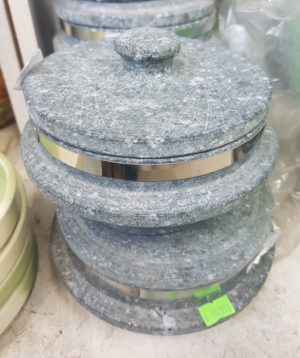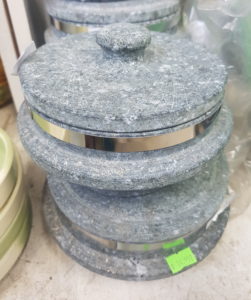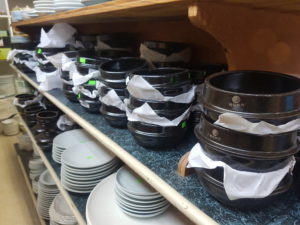Dolsot and Ddukbaegi Pots

These two Korean cooking vesicles are very similar. In fact, they are used in exactly the same way. One just costs more than the other.
A very traditional piece of Korean cookery, the dolsot is a stone pot that usually comes with a lid. Oringinally made from agalmatolite they are now most commonly produced from granite. This style of pot needs to be seasoned when first purchased, but it’s a very simple process and I’ve added the instructions below. When you are looking to purchase a stone dolsot, look for one that has the metal rings around both the rim and the bottom. These help keep your pot from cracking. There will probably be a time when you find small superficial cracks, and these are fine. You just don’t want cracks all the way through that will allow liquids to seep. More about that in a moment.
As for the Ddukbaegi (dook-bay-gee) this is simply a ceramic version that may or may not come with a lid. For both of these pots, there are wooden lid options sold separately. A new ddukbaegi does not need to be seasoned.
Both pots are very easy to clean, with a simple scrub with a rag or sponge and hot water. No soap or scouring should be needed.
To use either a dolsot or ddukbaegi you simply place it right on your stove top burner, either gas or electric, but you want to start with low heat first, for about 2 minutes. This will allow the pot to warm up slowly and not crack. After a few minutes you can turn the heat to medium. The advantage of these pots is that you really won’t ever need a high flame. The thick pot will collect the heat from a medium flame and be able to boil or saute with no problems. It will also hold onto that heat, so for many dishes, especially rice, you turn the heat right back down to low and let your food simmer and finish. The pot still retains the heat, nothing burns, and you save on your energy bill!
You can also bake in either a dolsot or ddukbaegi. Basically anything you can do with cast iron you can do with these Korean pots. Just be aware that you will need oven mitts or a towel to transport your cooked dish, and a trivet to set it on. They also have special wooden box/trays for this application if you are so inclined.
These pots are cheap! Well, the ceramic ones in particular. And they come in all different sizes, from teeny little ones that might be good for child size portions, all the way up to huge family gathering pots. We got a relatively small one for our son and larger one for Andrew and I to share. This allows us to separate our spicy inclinations, as well as customize Nathan’s version of the dish with ingredients he may prefer.
You can get these pots online, but I highly suggest looking for one at your local Asian Market. They will probably be cheaper and you’d be ‘supporting local.’
I’ve made a few dishes so far using our ddukbaegi. As I create more I will add them to this list. Here, I also offer some suggestions for other dishes that might be easy or traditionally made in a dolsot or ddukbaegi:
- Simple Steamed Rice
- Bibimbap – Korean Mixed Rice
- Bulgogi – Korean BBQ
- Shakshouka – North African Breakfast/Dinner
- Doenjang Jjigae – Korean Stew with Soybean Paste
- Kimchi sundubu-jjigae – Kimchi and Tofu Stew
- Dubu Jorim – Sweet Garlic and Soy Braised Tofu
- Any number of Banchan – in particular:
- Other simmered grains such as sorghum, quinoa, or millet
- Fondu
- Small soup or stew; guk or jjigae
- Curry Stews
- Noodles and broth
- Stir-fried rice
- Tagine
- Sauteed Vegetables
- Re-heated small portions of left-overs
- Other clay pot dishes traditional to other cultures.
To season a stone dolsot pot:
(Ceramic ddukbaegi do not need to be seasoned)
- First rinse it well with clean water.
- Then fill it again about 3/4 full with the addition of a tablespoon of salt. Place it on the burner over low heat, then bring this up to medium after about 2 minutes, and allow to simmer/boil for 10 minutes.
- Using oven mitts or a towel, dump out the water and allow the bowl to cool to the touch.
- With either olive oil or sesame oil, which ever you prefer flavor-wise, coat the inside surface completely. The bowl is going to absorb much of this. Continue adding oil as needed, until the stone no longer absorbs it, then wipe off excess. Your pot is ready!


